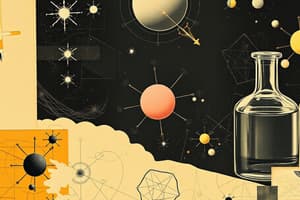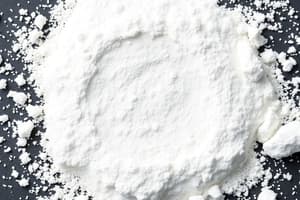Podcast
Questions and Answers
What is a defining characteristic of pure substances?
What is a defining characteristic of pure substances?
- Have a unique set of physical properties (correct)
- Consist of two or more components
- Have indefinite composition
- Can be separated by physical means
Which of the following is NOT a phase of matter?
Which of the following is NOT a phase of matter?
- Solid
- Liquid
- Gas
- Element (correct)
What happens to the boiling point of a liquid when impurities are present?
What happens to the boiling point of a liquid when impurities are present?
- It has no effect on the boiling point
- It raises and widens (correct)
- It becomes lower and narrower
- It remains constant
Which change in matter is considered irreversible?
Which change in matter is considered irreversible?
Which of the following best describes an impure substance?
Which of the following best describes an impure substance?
What type of change is cutting wood classified as?
What type of change is cutting wood classified as?
Which criterion listed does NOT characterize purity in a chemical substance?
Which criterion listed does NOT characterize purity in a chemical substance?
What is the main difference between physical and chemical changes?
What is the main difference between physical and chemical changes?
What distinguishes a compound from a mixture?
What distinguishes a compound from a mixture?
Which of the following is a property of elements?
Which of the following is a property of elements?
Which separation technique is used for removing solid impurities from a liquid?
Which separation technique is used for removing solid impurities from a liquid?
What is the main basis for separation techniques utilized in mixtures?
What is the main basis for separation techniques utilized in mixtures?
Which technique is NOT used for separating miscible liquids?
Which technique is NOT used for separating miscible liquids?
What is an example of a separation technique for solid mixtures?
What is an example of a separation technique for solid mixtures?
Which of the following best describes a mixture?
Which of the following best describes a mixture?
What is the purpose of evaporation to dryness in separation techniques?
What is the purpose of evaporation to dryness in separation techniques?
Which element is an example of a gas at room temperature?
Which element is an example of a gas at room temperature?
What is the difference between adsorption and absorption?
What is the difference between adsorption and absorption?
Flashcards
Matter definition
Matter definition
Anything that has mass and occupies space (volume).
Physical Classification of Matter
Physical Classification of Matter
Categorizing matter based on its physical state (solid, liquid, gas, plasma).
Chemical Classification of Matter
Chemical Classification of Matter
Categorizing matter based on its composition (pure substances, mixtures).
Pure Substance
Pure Substance
Signup and view all the flashcards
Impure Substance
Impure Substance
Signup and view all the flashcards
Physical Change
Physical Change
Signup and view all the flashcards
Chemical Change
Chemical Change
Signup and view all the flashcards
Purity Criteria
Purity Criteria
Signup and view all the flashcards
Element
Element
Signup and view all the flashcards
Compound
Compound
Signup and view all the flashcards
Mixture
Mixture
Signup and view all the flashcards
Separation Techniques
Separation Techniques
Signup and view all the flashcards
Sieving
Sieving
Signup and view all the flashcards
Filtration
Filtration
Signup and view all the flashcards
Distillation
Distillation
Signup and view all the flashcards
Solubility
Solubility
Signup and view all the flashcards
Evaporation
Evaporation
Signup and view all the flashcards
Study Notes
Matter: Definition and Classification
- Matter is anything that has mass and occupies space (volume).
- Matter can be seen or unseen. Examples include phones, air, and sand.
- Matter is classified physically (by state) or chemically (by composition).
Physical Classification of Matter
- Solids, liquids, gases, and plasma are physical states of matter.
Chemical Classification of Matter
- Pure Substances:
- Have a definite, uniform composition.
- Components are homogenous (same phase).
- Cannot be separated by physical means.
- Have unique physical properties (e.g., melting point, boiling point, density).
- Examples include elements and compounds.
- Impure Substances (Mixtures):
- Have a variable composition of two or more pure substances.
- Constituents retain their individual properties.
- Can be separated by physical methods.
- Examples include alloys and various mixtures.
Criteria for Purity of Substances
- Density: Pure substances have a constant, defined density; impure substances have variable densities usually higher than expected.
- Boiling Point: Pure liquids have a sharp boiling point with a narrow range; impurities raise the boiling point and widen the range.
- Melting Point: Pure solids have a sharp melting point with a narrow range; impurities lower the melting point and widen the range.
- Freezing Point: Pure liquids have a sharp freezing point; impurities lower the freezing point.
Changes in Matter
- Physical Changes: Alter the physical state or properties of matter; easily reversible. Examples include changes of state (boiling, melting, freezing), breaking objects, etc.
- Chemical Changes: Alter the chemical properties of matter, forming new substances; often accompanied by energy changes; not easily reversible. Examples include rusting, souring milk.
Elements, Compounds, and Mixtures
-
Elements: Substances that cannot be broken down into simpler substances; consist of one type of atom. Examples include hydrogen, oxygen, nitrogen.
-
Compounds: Substances made from two or more elements chemically bonded together. Can only be separated by chemical changes. Examples include water (H₂O), calcium carbonate(CaCO3).
-
Mixtures: Substances made from two or more pure substances physically combined; components retain their identities; can be separated by physical methods. Examples include alloys, various blends and mixtures of substances.
Separation Techniques
- Separation techniques are physical methods used to isolate components of mixtures. Basis of these techniques are the differing physical properties of mixture components.
Separation Techniques for Mixtures of Solids
- Sieving
- Sublimation
- Magnetism
Separation Techniques for Mixtures of Insoluble Solid and Liquid
- Filtration
- Decantation
- Centrifugation
Separation Techniques for Mixtures of Soluble Solid and Liquid
- Evaporation to dryness
- Crystallization
- Fractional Crystallization
- Precipitation
- Simple Distillation
Separation Techniques for Mixtures of Miscible Liquids
- Simple Distillation
- Fractional Distillation
Separation Techniques for Mixtures of Immiscible Liquids
- Separatory Funnel
Studying That Suits You
Use AI to generate personalized quizzes and flashcards to suit your learning preferences.




